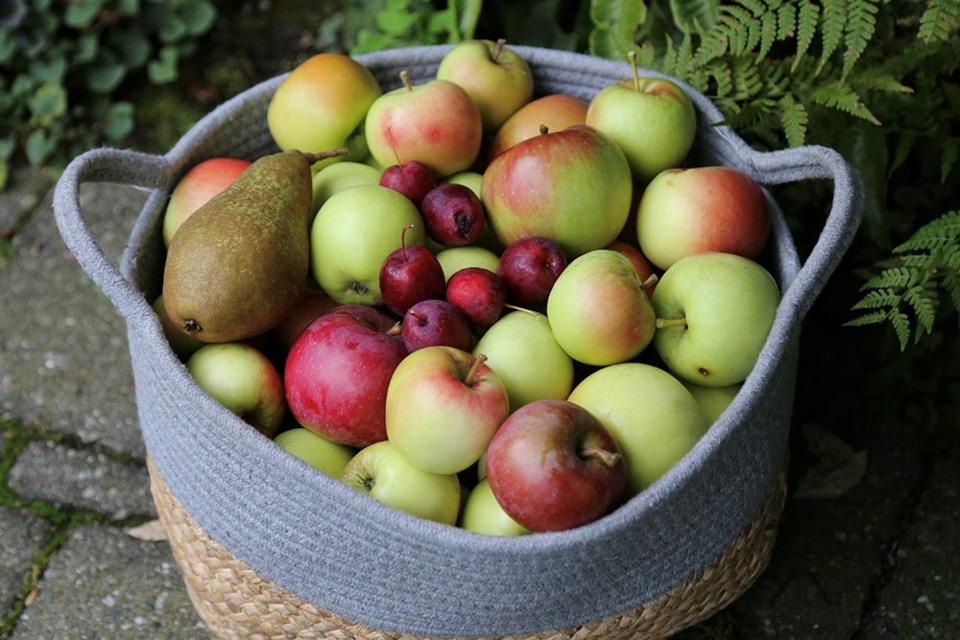In permaculture circles, nose to tail eating applies equally to the preparation and consumption of vegetables and fruit as it does to animal protein. There are few things as satisfying as fully exploiting every bit of potential from a tomato, pear, asparagus spear, or anything at all really, before the truly unusable bits end up in the compost.
In our kitchen, root vegetable peelings get minced and cooked, for daily consumption by veggie dog Dave. Herb stalks, woody asparagus ends, remnant vegetables, prep tops and tails, and most green kitchen scraps accumulate in the freezer for eventual use as vegetable stock fodder. Onion and skins add beautiful gold or green colour to vegetable, meat and seafood stocks, Easter eggs, even fabric and yarn.
My new favourite #wastenothing tradition presented itself quite naturally last season when our tiny orchard of dwarf fruit trees gifted us its first crop — a small but precious basket of gorgeous apples and pears. The care and feeding of the diminutive trees, and every morsel of precious sunshine and water they had consumed over the summer weighed heavily as I considered options for preparation.
As tempted as we were to dive in and snack on the succulent fruit, we decided instead to preserve it. Our children suggested that I make fruit butter to savour repeatedly all winter long on toast, in baking, on pancakes, on and in homemade ice cream, and by the delicious spoonful.
And so it was that Apple Pear Schmear, Apple Scrap Vinegar and Scrap Must were born. It isn’t necessary to grow your own produce to adopt a waste nothing ethos, but food gardening does awaken an increasingly important awareness of waste and potential.
According to the National Zero Waste Council, 63 per cent of the food thrown away by Canadians could have been eaten. On average, households toss 140 kilograms of edibles with a value of over $1,100 into landfills, annually. As a nation, we waste 2.2 million tonnes of edibles worth more than $17 billion every year, and of this total, 45 per cent comprises vegetables and fruit. In the anaerobic environment of a landfill, organics produce methane gas, a potent greenhouse gas that traps 25-85 times more heat in the atmosphere than carbon dioxide. Yikes!
Painful statistics when considered against a global backdrop of code-red level climate change, increasing food insecurity, and an unprecedented refugee crisis. Shame on us, really. I am guilty, as is my family. We are all guilty to greater or lesser degree. The good news is that we can change our ways by conserving at both ends of the food supply chain — buying only what we need, growing some quantity of food at home in whatever space we have, and using every last scrap of it, somehow.
Imagine a new culture of conservative conservation, where less is more, doing without equates socially with doing well, and sharing #wastenothing DIYs and DYKs across social media gain higher page rank than celebrity hangouts. Imagine.
In the interim, some homework!
Apple Pear Schmear
- apples, quartered, peeled and cored (reserve peels and cores)
- pears (optional), quartered and cored, peel on (compost cores)
- handful of plump raisins or barberries (I oven-dried Concord grapes)
- honey to taste (optional)
- apple cider vinegar to taste (optional)
- finely ground ethnic spice blend to taste (Thai, Moroccan, Curry, Chinese)
- grated ginger root, to taste
Add fruit to a heavy-bottom dutch oven or stock pot and add just enough water to keep it from burning while cooking on medium heat. Stir often. When soft, let cool enough to blend or whiz into a fine pulp. Return to pan; add honey and/or vinegar to taste, add spice and ginger, reduce (keep stirring) over low heat until thick like porridge. Add dried fruit, stir and let cool. Hot-water process for 10 minutes in 500ml sterilized jars.
Apple Scrap Vinegar
Add reserved apple peels, pips and cores to sterilized glass jars, cover with tepid spring water, add sugar or honey (15ml per 250ml water). Stir; cover with muslin, let stand draft-free for six to eight weeks, stirring occasionally. Strain, settle, bottle. Use residual applesauce-like ‘must’ for baking. *If after 10-14 days the mixture does not smell vinegary, boost with 5ml cider vinegar (with mother) per 250ml.
Laura Marie Neubert is a West Vancouver-based urban permaculture designer. Follow her on Instagram @upfrontandbeautiful, learn more about permaculture by visiting her Upfront & Beautiful website or email your questions to her here.
For a taste of permaculture, click on the YouTube link below:



